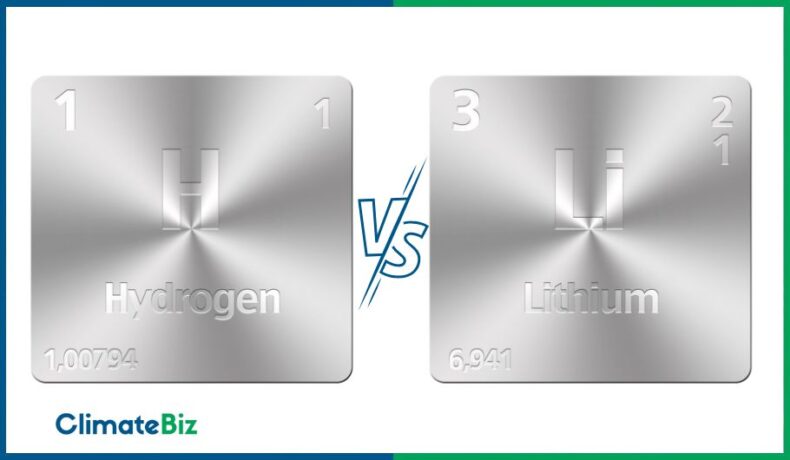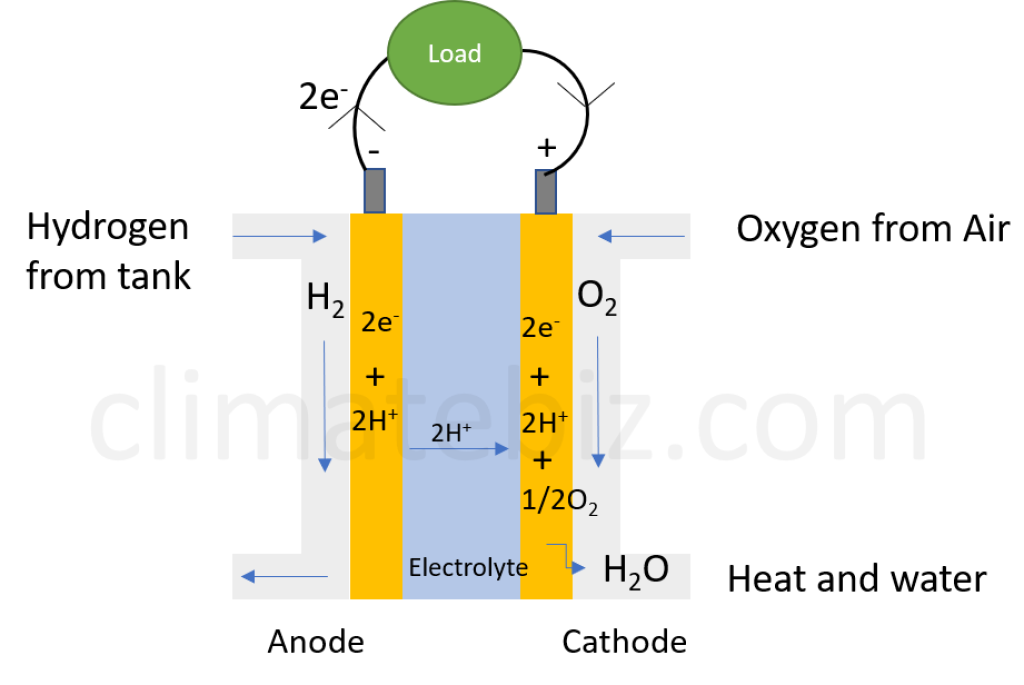.
Electric automobiles, EVs, are viewed as the future of movement. In 2022, they

represent 6%(* )of all lorry sales in the United States, with a target of 50% by 2030. Some nations go even further. In Europe, the sale of brand-new fuel vehicles will be prohibited beginning in 2035.
In this technical transformation, oil is changed by electrical power and our gas tank by lithium-ion batteries. Nevertheless, like all brand-new innovations, lithium-ion is not without its defects, and an opposition, the hydrogen fuel cell, might likewise get its share of the pie.
Let’s evaluation both innovations and discover what the future of electrical automobiles appears like. Foreword Climatebiz specialists style, research study, fact-check & & modify all work diligently.
Affiliate Disclaimer
Climatebiz is reader-supported. We might make an affiliate commission when you purchase through links on our website.
$ 600 Off
Utilize our voucher code to get this restricted offer from EcoFlow while it lasts. Back up your house throughout power blackouts with the DELTA Max + 110W photovoltaic panel.
Hydrogen fuel cells vs. lithium-ion batteries: what’s the distinction?
There is a significant distinction in between hydrogen fuel cells and lithium-ion batteries: A fuel cell creates electrical power from hydrogen (H
2
) and oxygen (O
2
), whereas lithium-ion battery shops and products electrical power and needs an external source for charging. As revealed listed below, the fuel cell is constantly combined with a hydrogen tank and a lithium-ion battery in an EV. Hydrogen fuel cells and lithium batteries both usage (electro) chain reaction to create or keep electrical power. Their active products and core responses are various, however they share the very same parts: Cathode.
Anode.

Separator (membrane).
Electrolyte.
- Existing collector.
- Let’s rapidly examine their working concept.
- Hydrogen fuel cell: working concept
- Hydrogen gas (the fuel) is fed at the anode, and air goes into by the cathode. A driver, generally platinum, at the anode separates hydrogen into protons (h
- +
) and electrons (e
—
). The electrons circulation into the electrical circuit, and the protons take a trip from the anode to the cathode to respond with oxygen and create water and heat as a spin-off. Working concept of a fuel cell. Lithium-ion battery: working concept A lithium-ion battery is a gadget that transforms electrical power into chemical energy. An electrochemical reversible response can keep electrical power (charging) or supply electrical power (discharging). In a lithium-ion battery, lithium ions (Li

) are exchanged in between the anode and the cathode.
Throughout the charging procedure, electrons circulation from the anode to the cathode causing a transfer of the lithium ions from the cathode to the anode. The opposite response takes place throughout discharge.
Working concept of lithium-ion battery. Are hydrogen fuel cells more effective than lithium-ion batteries? The effectiveness of a hydrogen fuel cell is around
50%.

The effectiveness of a lithium-ion battery is around
98% Almost all electrons that go through the battery are efficiently kept and launched (charge and discharge). Nevertheless, keep in my mind that we
can not straight compare the effectiveness of a fuel cell and a lithium-ion battery. Undoubtedly, the fuel cell creates electrical power
from a main energy source (hydrogen), and the battery shops electrical power and requires an external source of electrical power to be charged. Hydrogen fuel cells vs. lithium-ion batteries: Facilities Undoubtedly, electrical automobiles will take control of our standard combustion engines in the future. For this energy transformation to come true, enormous facilities financial investments are required. The advancements are primarily concentrated on the following:
Production centers.
Circulation system.
Charging station.
In the chart below, we have actually summed up the facilities required for both innovations:
- Hydrogen fuel cells
- Li-ion batteries
- Production centers
Hydrogen production plants
| Power plants | Circulation system | |
|---|---|---|
| Pipelines and tanks | Electrical transmission lines | Charging station |
| Hydrogen filling up station | Charging stations | Li-ion batteries facilities |
| Although rather current, Li-ion is the most fully grown innovation. | The primary difficulty with EVs is to provide electrical power rapidly to several places. | In 2022, the typical EV battery size is 50kWh, with a charging time (10% -80%) of 35 minutes on a quick charging station vs. 7 minutes on a complete gas tank. This is the powerlessness of electrical automobiles: |
the sluggishness of charging.
This technical issue is a substantial difficulty for engineers. On the one hand, they are attempting to enhance batteries to accept greater charging power. On the other hand, they are dealing with the technical difficulty of providing high-power charging stations.
Presently, the Tesla supercharger reaches 250kW, and your EV will get 200 miles of additional autonomy in 15 minutes. This is still really far from our fuel vehicles. To cut the recharge time by 2, we would require a 500kW supercharger.
Now let’s do a basic estimation
, if 5 vehicles are linked to a charging station, the immediate power required is 2.5 MW.
There are more than 140,000 EV battery chargers in the United States (53,000 charging stations). If all charging stations are geared up with a future 500kW supercharger, the immediate power required would be approximately 53′ 000 x 2.5 MW= 132GW.
This is comparable to 132 atomic power plants! In conclusion, we require big financial investments in brand-new power plants and electrical power grids for EVs to be enormously embraced
Hydrogen fuel cell facilities
Promoted by Jeremy Rifkin in his book the
hydrogen economy (2002 ). Hydrogen is viewed as the most appealing prospect to change our nonrenewable fuel source economy.
Nevertheless, after more than twenty years, the advancement of facilities is still very restricted.
Changing from fuel to hydrogen needs enormous financial investment in hydrogen production centers, circulation, and filling up stations. Hydrogen does not exist as a natural source and requires to be produced. Presently, 98% of hydrogen production is from nonrenewable fuel sources. The difficulty is to change to sustainable sources such as water electrolysis
powered by solar or wind energy.
With just 107 filling up stations in the United States, the hydrogen circulation system is very restricted. There is still
a long method to go prior to hydrogen and fuel cells come true for our automobiles. Will hydrogen vehicles surpass electrical automobiles?
Over the long term– 30 to 40 years– there is an opportunity for hydrogen vehicles to surpass electrical automobiles. The primary factor is that it is a lot easier to keep and move hydrogen than electrical power
Semi-commercial hydrogen vehicles can currently attain quick refilling, acquiring 300 miles in
3 to 5 minutes, with an overall series of more than 840 miles for the Toyota Mirai
That stated, we’re still far from seeing hydrogen fuel cells ending up being mainstream. Hydrogen vs. lithium-ion: what does the future appear like? There is no doubt that the future of automobile is electrical
, however will our future electrical vehicles be powered by lithium-ion batteries or fuel cells?
Although fuel cell vehicles can currently attain quick refilling and hold the very same autonomies as fuel vehicles, it is most likely that the innovation will not take control of the EV market yet.
To come true, the hydrogen economy requires big financial investments throughout all its worth chain in the numerous billions of dollars. For the next 20 to thirty years, the lithium-ion battery will be the leading EV innovation. In the future, we can anticipate 5 significant enhancements for battery-powered EVs:
Cost decrease, with the enormous adoption of electrical vehicles, the rates are most likely to drop.
Increased autonomy by enhancing battery capability.
Enhanced security with solid-state battery.
More charging stations.
- Quick charging.
- The last point is the most difficult, can we produce sufficient electrical power for our electrical vehicles, and can the electrical grid deal with big power need?
- According to experts
- , it is possible as long as we thoroughly prepare the building and construction of brand-new power plants.
- Last ideas
Hydrogen is thought about the fuel of the future; it is extremely energetic and can be produced from renewable resource and water.
Fuel cells transform hydrogen into electrical power and just discharge water and heat as a spin-off. Enormous R&D financial investments in the early 2000s resulted in the advancement of fuel cell-powered automobiles that can currently attain quick refilling and long variety.
The primary barrier to this innovation ending up being mainstream is the enormous facilities financial investments. For this factor, we will not see any hydrogen vehicles on our roadways prior to 20 to thirty years.
On the other hand, lithium-ion innovation is enormously embraced for EVs. Lithium batteries still struggle with low recharge speed and restricted autonomy vs. fuel vehicles, however we can anticipate fast enhancement.
The most difficult part is establishing charging facilities and power plants to fill up the numerous countless EVs that will be out on the roadway in the next twenty years.
Are you thinking about hydrogen and its future applications? We have actually crafted an available
do it yourself fuel cell job
to acquaint ourselves with the innovation.
.
